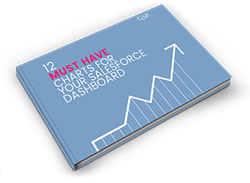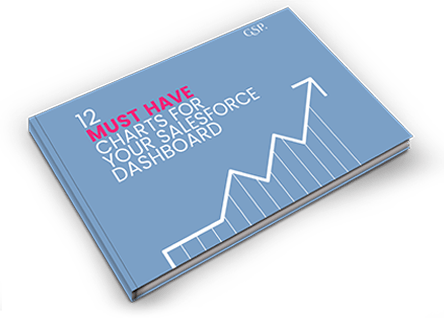How To Measure Opportunity Conversion Rates Correctly
Opportunity conversion rates are a critical metric in any sales team.
That’s because when all is said and done, there are only three ways to increase revenue.
- Grow the pipeline.
- Raise the average deal size.
- Increase your opportunity conversion rate.
Of course, they’re all important.
However, improving your sales conversion rates is often the quickest way to increase sales. So naturally, you want to measure the ratio.
Not only that:
Tracking conversion rates helps you understand how to improve individual salesperson performance.
Nevertheless, be careful.
There is a right and wrong way to measure opportunity win rates.
So, naturally, I’ll explain the correct method.
(By the way, before we get started, what about those other two ways to increase sales? Here’s the dashboard chart that shows the trend in the size of your pipeline. And if you’re interested in average deal size right now, read this).
Note about terms:
Most people use the terms opportunity conversion rates, win rates, and sales conversion rates interchangeably. We do the same; I assume these three phrases all mean the same thing.
How To Measure Opportunity Conversion Rates
There’s more than one way to calculate opportunity conversion rates in Salesforce.
The Wrong Way To Measure Sales Win Rates
Sometimes people try to measure win rates as a proportion of the total pipeline.
In other words, the conversion rate is the value of closed-won deals in a month as a proportion of the total open pipeline.
However, this gives a distorted win rate.
For example, let’s say your sales cycle is three months.
That means deals created today are unlikely to close for another two to three months. So they are not relevant to the sales conversion rate for this month.
In other words, if the sales team closes the usual number of deals this month and does a great job creating pipeline opportunities, the win rate is artificially low.
Instead, I recommend you measure your opportunity conversion rate like this:
The Right Way To Measure Sales Conversion Rates
You measure opportunity win rates by comparing the number and value of deals won with those lost in the same period.
For example, if you win 30 deals and lose 70 opportunities in a month, your sales conversion rate by value is 30%. Likewise, if you win $40,000 of business and lose $60,000 in the same period, your win rate by dollar value is 40%.
This method is a clear and straightforward way to measure opportunity conversion rates. It’s also quick and easy to track in Salesforce.
How To Measure Sales Conversion in Salesforce
This Salesforce dashboard chart shows the ratio of won to lost deals each month.
The pipeline, including deals that get pushed from one month to another, plays no part in calculating the conversion rate.
Measuring Conversion Rates by Value and Number
Our dashboard chart shows the conversion rate in two ways.
- Won % (Count). This metric is the percentage conversion rate in terms of the number of won opportunities.
- Won % (Amount). This metric is the percentage conversion rate in terms of the total value of won opportunities.
There’s a significant trend in the chart.
The chart shows that in three months – July, August, and October – the conversion rate by Amount was higher than the win rate by Count.
That’s probably a good thing because it means that more high-value opportunities were successfully closed compared to lower value opportunities.
In September, the trend reverses. It appears that more low-value opportunities closed successfully.
That’s something we’ll want to investigate.
The overall opportunity conversion rates are around 35% in this company. Two months – July and October – exceed 40%. That’s relatively high. Is it a good thing? Perhaps. Let’s investigate further.
Our 27 page eBook shows you the 12 killer
Sales Charts for your dashboard.
Salesforce Opportunity Conversion Rate Report
Here’s the report for the chart.
In addition to the Won % (Count) and Won % (Amount), the report shows:
- Sum of Amount. The total value of Closed-Won and Lost deals in the month.
- Sum of Amount Won. The value of Won deals in the month.
These additional metrics are helpful because they put the opportunity conversion rates into context.
For example, Shaun Yates has a 100 percent sales conversion rate for October. On the other hand, the Amount Won is only £5,000 – that’s small compared to the total value won by other salespeople in the month.
How To Interpret The Opportunity Conversion Report
Like any other Salesforce report, we need to know how to use it.
Here are five insights we can gain from the report above. Don’t forget that we need to validate each idea through further reports and investigation.
- Dave Apthorp focuses on higher-value deals. Dave’s Won % (Amount) is consistently higher than the Won % (Count). A previous blog post tells us why that is. Dave featured in the post, The Best and the Worst Salesperson on the salesforce dashboard. It turns out that Dave puts all of his eggs in the two or three biggest deals each quarter. He virtually ignores all the rest.
- John Davies has the lowest opportunity conversion rates. On the face of it, John will benefit from coaching to improve his win rates. But we need to check that there isn’t more to it than just that. Is John focused more on new rather than existing customers? Is he operating in a new market? Or is he converting Leads into Opportunities much earlier than other salespeople and then qualifying them out at an early stage?
- Sarah Watson focuses on lower-value deals. Sarah’s opportunity conversion rate is much better in Count than Amount. Potentially she needs guidance on her approach to opportunity prioritization. Alternatively, she needs coaching and more experience in handling large deals.
- Consistently, Shaun Yates has the highest opportunity conversion rates. Does this mean Shaun is a superstar salesperson? Perhaps. But his full-year conversion rate of 55% is suspiciously high. Potentially Shaun is keeping opportunities out of the pipeline until he’s confident that a deal is almost certainly on. Reviewing the time in stage velocity metrics will help determine this.
Be Careful Using Sales Conversion Rates
Looking at opportunity conversion rates is an excellent way to spot the team leader’s actions that will increase sales.
However, it’s essential to use other reports and dashboard charts to confirm your insights. Most of all, you need to be careful not to encourage tactics that reduce your pipeline visibility.
I’ll explain:
- Sandbagging: This happens when salespeople keep deals out of the sales pipeline until a positive outcome is on the cards.
In our example, we might suspect Shaun of sandbagging. How do we know? Well, his win rate is very high. Perhaps he’s a fantastic salesperson. On the other hand, maybe he only introduces some deals into the pipeline when he’s confident of a successful outcome. The impact is to boost his sales conversion rates. Unfortunately, this means we lack complete visibility of the sales pipeline and potential revenue.
- Pipeline over-inflation: This is the opposite of sandbagging. Deals that are well past their sell-by date never get closed.
There are many reasons why deals do not get closed out of the sales pipeline. For example, optimism that an agreement will happen one day or manager pressure to maintain the size of the pipeline.
Again, the result is to distort funnel visibility.
You can avoid these issues by using opportunity conversion rates in conjunction with other measures. For example, track average deal size, deal quality metrics, and sales velocity measures.
Using Sales Conversion Rates To Increase Sales
So let’s say our analysis is complete and we’re happy with the numbers.
Here are seven ways you can use opportunity conversion rates to boost your sales revenue.
- Opportunity qualification: Low sales conversion rates are not necessarily a bad thing. As Bud Suse points out, there’s no point spending a lot of time and effort on a deal only to come a close second. Far better to qualify out of those deals where you have a low chance of success.
- Share and learn: Identify the salespeople with high opportunity win rates. Share and learn from their experience and spread their skills across the team.
- Teach: Train and coach each rep on ways to improve their opportunity conversion rates. Walk through a couple of deals they didn’t win, and work out what you can do differently next time.
- Territory analysis: Compare conversion rates across regions. Identify and share lessons across territories.
- Customer types: Optimize sales revenue by adjusting the balance between new and existing customers.
- Value proposition: Test the impact of different marketing campaigns and go-to-market strategies.
- Funnel leakage: Use conversion rates in conjunction with Leaking Funnel reports, so we understand how and why deals are lost from the sales pipeline.
Opportunity conversion rate reports are a powerful sales tool. Use them to increase sales revenue in your business today.

Don’t have time to read the entire Blog Post right now?
No problem.
You can download the entire “Your Sales Forecast Is Probably Wrong” eBook for free by completing the form below!







